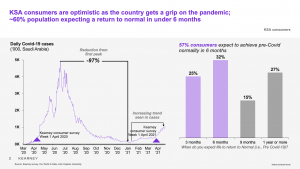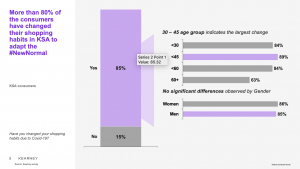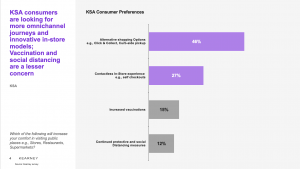6 in 10 Saudi consumers expect to return to pre-COVID normality in the next six months
A survey by Kearney Middle East
Authors:
Debashish Mukherjee, Partner, Dubai debashish.mukherjee@kearney.com
Mohammed Dhedhi, Principal, Dubai mohammed.dhedhi@kearney.com
COVID-19 has reshaped the way businesses operate, and consumers shop across the globe. The initial responses to the pandemic varied widely by geography, nationality, economic standing, educational level, access to vaccines, and political positions. As we enter the second year of what some call the “new normal” and others refer to as the “no normal,” those responses remain dynamic, continuously evolving and impacting retailing and shopping behaviors in real-time. However you define it, the crucial issue is which of the COVID-related changes will disappear as the virus recedes and which will remain in a post-pandemic world.
To answer that question, Kearney Middle East has been polling consumers in the Kingdom of Saudi Arabia (KSA) for more than a year. An initial survey of 500 shoppers was launched in April 2020. A follow-up study of 200 was put on the market a month later. In April 2021, the third research with 250 respondents from each country was conducted. Taken together, the three research instruments help us see how shopping behaviors have and may change.
The margin of error for all three surveys was 7 percent at a 95 percent confidence level.

Riyadh, Kingdom of Saudi Arabia, June 2021 – Alternative shopping options like Click & Collect, curbside pickup (46%), and contactless in-store experiences like self-checkouts (27%) will be key to rebuilding Saudi consumers’ confidence to visit public places (stores and supermarkets) moving forward. According to a study commissioned by Kearney, the third in a series of surveys exploring consumer shopping habits since the onset of the pandemic.
The results reveal that as spending habits continue to evolve, consumers in the Kingdom stay cautious. It also highlights that expenditure on essential items (which constitutes food and grocery (F&B) as well as non-F&B items like health and wellness products) has shown a sustained increase with 45% of consumers moving to higher-priced, better quality products, while spending on non-essentials (clothes, bags, and accessories) continues to decline.
More than 80% of consumers have admittedly changed their shopping habits to adapt to the “new normal,” with those aged between 30-45 recorded the highest change (89%), followed by those from ages 46-60 and under 30 years of age at 84% respectively.

When looking more closely into how habits have changed, 18% have reduced expenditure on essential items by up to 50% compared to pre-pandemic. However, over 60% of respondents have increased spending by over 25%. Conversely, spending on non-essentials has decreased by 26%, with 45% of respondents increasing spend in this area.
45% of respondents have upgraded to higher-priced, better quality items within the essential item category, with the highest increase shown for meats and dairy (61%) and fruits and vegetables (59%).
31% of respondents have highlighted that they expect to spend more on non-essentials in the coming months, particularly on casualwear (48%) followed by workwear (41%), evening wear (39%), activewear (36%), footwear (34%), and bags and accessories (27%).
“The pandemic has fundamentally changed the way consumers view health and safety measures and efforts. As residents adapt to the new normal, hygiene and hygiene transparency, have become vital. Spending is being driven by the easing of restrictions, higher awareness of health and wellbeing, and expectations to return to the office,” Debashish Mukherjee, Partner & Head of Consumer Industries and Retail Practice at Kearney Middle East, said.
As spending habits evolve, e-commerce continues to penetrate all categories. The survey highlights consumers in the Kingdom are now more comfortable purchasing essentials online than last year. When questioned about the motivations behind this, COVID-19 prevention measures (39%) were the main drivers, followed by convenience (36%), price (17%), and finally, assortments of products (8%).
COVID-19 prevention measures ranked third for online shopping for non-essential items (18%), preceded by convenience (34%) and price and an assortment of products ranking equally at 24% each.
Interestingly, consumers were looking for more omnichannel journeys and innovative in-store models with alternative shopping options and continued protective and Contactless In-Store experiences like self-checkouts being the key drivers of restoring consumer confidence in visiting public places and increased vaccination (15%) and social distancing (12%) being a lesser concern with (16%) in increasing their confidence.

Saying this, 44% of respondents highlighted an offline-shopping preference for essential items and 35% for non-essential items, particularly for those products that require inspection for quality, freshness, and fit.
“For Saudi consumers, convenience is driving online purchases with COVID-19 concerns becoming a secondary factor, indicating the sustenance of the online shift. However, the physical store still plays a strong role across all categories, which require the customer to touch, feel and try the product. Retailers will need to adopt a differentiated strategy to make consumers feel safe in stores; consumers are heavily indexed towards alternative shopping options like Click & Collect, curbside pickup, and contactless in-store experiences like self-checkouts; however, this will vary across markets and its essential for stakeholders, mall property owners, and retailers to monitor the evolving face of retail to ensure they stay relevant,” Mukherjee said.
About Kearney
As a global consulting partnership in more than 40 countries, our people make us who we are. We’re individuals who take as much joy from those we work with as the work itself. Driven to be the difference between a big idea and making it happen, we help our client’s breakthrough. Mukatafa is honored to have their continued partnership to bring data analyses like this to life.
To learn more about Kearney, please visit www.kearney.com.
